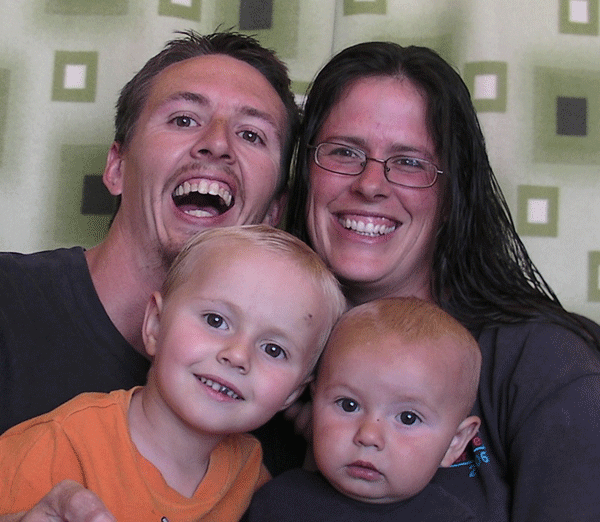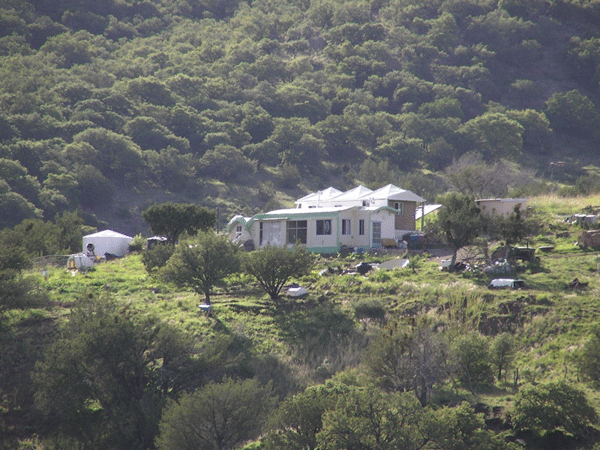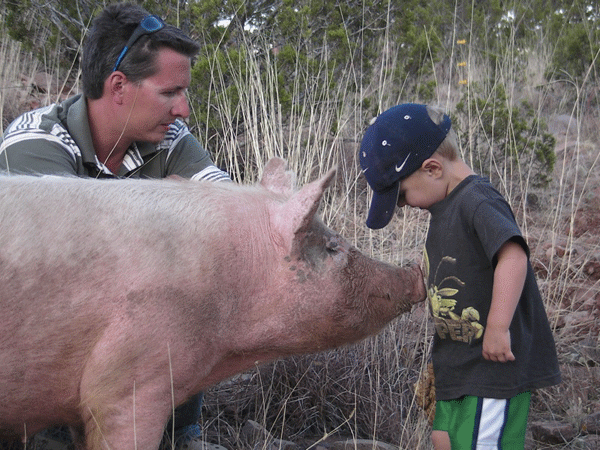Abe and Josie Connally are two of my maker heros. Their infectious positivity and passion for preserving the environment fuel their unfaltering dedication to living the DIY off-grid homesteading dream. They’ve built their homestead from the ground up in the hills of Chihuahua, Mexico, and they relish in sharing their know-how with the greater maker community through their site, Vela Creations. Their names have appeared in at least 11 volumes of MAKE, and they’ve taught us how to make wind generators, seed starters, honey cows, solar food dryers, compressed earth brick floors, fabric-formed posts, solar wax melters, and more. We recently caught up with Abe to get a window into off-grid life: building, growing, teaching, and raising two beautiful kids.
1. What was your first foray into off-grid living?
We bought 20 acres of pristine desert in southwest Texas, where we met. There was nothing on or near it — no structure, water, electricity, phone, sewage, etc. It was 30 miles from the nearest population and 60 miles from the closest town. We started off living in a small bus, retrofitted with solar panels, kitchen, bed, table, and shelves. Piece by piece, we built our own amenities: an adobe house, rainwater catchment, a power system with solar and wind, composting toilet, garden, goats, and chickens. As we figured out how to handle each aspect of living off-grid, we became increasingly addicted.
2. Tell us about the homestead you and your wife Josie have created.
We have lived on our current property for 5 years now. This is our second off-grid homestead built from scratch. We started off building small: one room, one water tank, a small power system, a basic garden. We called it the “off-grid starter kit.” Each year we have added to each system, integrating them as much as possible to increase efficiency.
The house (now very spacious at 1300 square feet) is half buried on the north, with huge windows on the south. In winter, the solar gain from the windows and hot water pipes under the brick floors heat the house, while the roof insulation and thermal mass of the earth keeps that heat in. In summer, it stays cool. Windows are placed for maximum through-breeze, while the thermal mass, insulation, and eaves over the windows prevent the heat from getting in.
We catch rainwater from the roof. We currently have 8000 gallons of storage capacity (including the tank on the rabbit shed), although those are already almost full after one month of rain. That is enough to last us through the nine dry months of the year. However, we plan to add more tanks this year, so that we can have gardens, fish, and orchards year round. We also have two new ponds, one of which is in the animal pastures, that are starting to fill. We have a solar water heating system that not only provides us with plenty of hot water, but also heats the floors in winter.
Our electricity comes from the wind and sun. We can run any appliance we want, although we are naturally conservative and never waste power needlessly. Both our fridge and freezer are super efficient, and we use low-energy appliances where possible (like laptops).
We produce a large part of our food requirements, and are currently working towards increasing that supply. So far, we have gardens, some fruit trees, pigs, rabbits, and poultry. We hope to include fish and more perennial vegetables this year.
Our waste streams are pretty low. We compost everything organic, or feed it to the earthworms and black soldier flies. And as for inorganic wastes, we either try to avoid or reuse them. We still have a ways to go before being completely self-sufficient, but we’re getting there, step by step.
3. How did you learn the homesteading skills you have?
We read and research a lot, both via books, magazines, and online. And then we jump in. Whatever we can’t learn from others, we figure out through trial and error (the error part often being the most instructive).
A lot of it was upbringing, too. We both had parents who encouraged us to learn and do things for ourselves. They took away the fear of trying something new. We have a natural curiosity about the world around us, and that helps us figure out how things work or should work.
4. What motivates you to share your knowledge with others?
Just as we have learned from others, we want to be able to give something back. Knowledge acquired purely for your own gains seems somehow hollow. The true joy comes from sharing. We often get comments that we have inspired or helped someone to do something, and that is almost better than getting to enjoy the things we create.
Plus, there have been several occasions when someone has done something using our information and then gone on to find a way to improve it, benefiting all of us. That’s the beauty of open source: the combination of all of our ideas, resources, and innovations will create a far stronger end product.
5. You recently gave a tour of your homestead to 20 professors. Tell us how that came about and what they were most interested in.
People have always found our homesteads to be interesting and exciting. They want to come check it out, hearing that we were doing things that are different. At first, it was individuals or families. Then they would bring friends.
A few of the professors that came as a group had been here before and decided they wanted to organize a larger gathering of like-minded colleagues. They were mostly professors of ecology, animal management, and architecture. Some were also members of the local and regional governments. They came here to see examples of concepts that work in real life.
The thing that caught their attention the most was the rainwater catchment and cisterns we have made. Our region has been in the grips of a major drought for the last year, and it has affected every aspect of life. Without water, life flounders, and to provide a whole homestead (with animals and plants included) with enough water to make it flourish at such little cost, is indeed an important accomplishment.
When nearby towns didn’t have enough water for their citizens, people started noticing that we always seemed to have plenty of water, even on this dry hilltop without a well, spring, or creek. This caught the attention of local and regional governments as a possible solution to their water shortages. So they came to see for themselves how we can do so much with so little.
6. What’s the hardest part of being off-grid? What are the unique challenges to raising kids off-grid?
Lots of people assume that raising kids off-grid might be hard, but that is not the case. In fact, kids seem naturally suited to this lifestyle. They are constantly outdoors. They love the animals, planting, hiking, and gathering that are involved in our lifestyle. And they get to see and participate in a variety of tasks; there’s always a lot to do on a homestead, but it is not monotonous and is not based on a set routine, which suits the attention span of small kids pretty well.
The hardest part of being off-grid is probably trying to remain patient. We started with nothing and have been gradually working towards self-sustainability. We’re not there yet, and that’s the rub. We start researching some project we want to do in the future and we get all excited. But there are so many demands on our time and we have to prioritize, so sometimes the exciting stuff just has to be added to the bottom of the list. So, part of living on a homestead is adapting to a different pace of how you approach projects.
7. Tell us about yourself: what’s your background, how did you get started making things, and who are your inspirations?
I was raised in rural New Mexico and Texas. My mom was a science teacher and my dad a rancher, so between those two, I was encouraged to participate in all kinds of projects and chores. Ever since I was a boy, I loved creating things out of junk. To this day, my greatest passion is figuring out how to use someone’s garbage to solve an engineering problem.
Josie was born in Africa, raised in Portugal and schooled in England. From both her grandparents and parents, she inherited a certain amount of wanderlust. She learned different languages and cultures fairly easily, simply from being exposed to them. After university she traveled and worked in several different places, from the Amazon jungle to a boat on the Mediterranean. Moving from place to place and across cultural and environmental lines opens up a certain adaptability, one that proves useful in the DIY mindset.
As for inspirations, there are too many to list. Everywhere you look there is something and someone that can teach and inspire you. We’ve been inspired by things as simple as petals on a flower. But, if it’s any help in answering your question, our first son, Leo, was named after Leonardo De Vinci, and Nico was named after Nikola Tesla.
8. What new idea/project has excited you most recently?
Our most exciting project at the moment is Food Web. This is an integrated and sustainable food production system. Food Web is a holistic approach to food, focusing on animal welfare, waste integration, water conservation, innovative feed systems, and profitability for small farmers. We’re making a working model of the idea, and writing a book. The book, Food Web Volume I, includes all details of construction and planning of the working model, as well as a full description of the input, output, integration, processing, and products of each animal included in the web.
We started a crowd-funded campaign through Indiegogo to help raise some money to give us a little boost and precipitate this endeavor. We raised 13% of our goal in the first day, so we’re very excited. If anyone wants to help out, they can visit the page and “like it,” pass it around to friends and family, or contribute in exchange for various reward packages.

9. What are your top three indispensable tools?
My favorite tool is my Casio calculator watch. I’m constantly playing with that thing, figuring out how many fish can be grown in a water tank, or the load of a concrete roof, or biofuel yield from a certain feedstock.
Our next favorite tool is the internet. Research plays a big part in what we do, and without the internet, it would really slow things down. The internet is an amazing resource for people like us.
One of the best, simple tools on a homestead is the water level. It’s basically a clear tube with water in it. So simple, yet extremely useful and accurate for getting a level over a large distance. We use it regularly to level sites for projects, water lines, swales, and countless other things around the homestead.
10. What advice would you give to folks who are interested in moving toward an off-grid lifestyle?
There are so many things that people can do to become a little more sustainable. The first and foremost is conservation. Turn lights off you’re not using, don’t run a tap needlessly, use efficient appliances. Try and look around you and see if you can become a little more streamline. Start looking at where your energy goes, where your water is used, and what you can do to reduce these footprints.
Trash is another big factor. Try and reuse inorganic items as much as possible and get some earthworms for everything organic. It is amazing how much soil-building material is just thrown away. Healthy soil is the path towards true wealth, so don’t let your wealth go to a landfill.
On most of the major systems, like energy, shelter, and water, we suggest building something small, just to get your feet wet and see if you like it. Make yourself a small shed or greenhouse, with rainwater catchment and a small power system. Or put a gutter on your existing roof, start recharging your batteries with a small solar panel, or make a swing for your kids. It’s amazing how addictive the DIY bug can be.
But perhaps, more than anything, we would suggest people try to produce some of their own food. That can be a tomato plant, a couple of chickens or rabbits, or a wicking bed. The possibilities are endless. It all depends on what you have space for. Homegrown food tastes so much better than anything you can buy, and it won’t have any kind of chemical or additive (unless you put one in). To us, food is synonymous with health, and that’s not something that we can trust to companies that only care about their profit margin.
That is what our Food Web concept is all about. It’s about getting people to start with something that they can participate in and take control of, like producing some food in their backyard. Once you start, you can look at ways to improve and optimize, from integrating animals to planting perennials for long-term production. But the key is taking that first step, no matter how small.
Never assume you can’t do something. Do your research, make your plans, and give it a go, no matter what it is. You’ll be amazed at what you can do!
For more information, visit Abe and Josie’s Vela Creations site. Also, be sure to check out a list of their MAKE articles and their how-tos in Make: Projects.
ADVERTISEMENT











